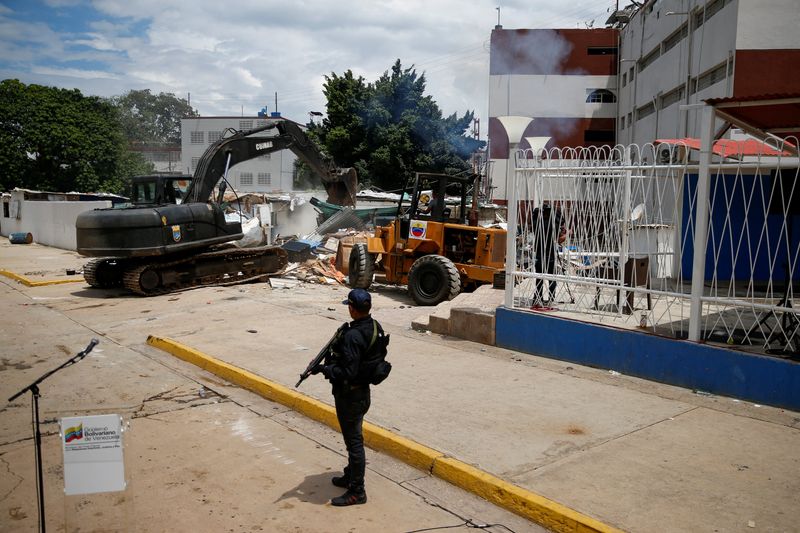Explainer-What is the Venezuelan prison gang Tren de Aragua?
2024.07.11 17:15
By Daniel Trotta and Jose del Pino
(Reuters) – The United States on Thursday placed sanctions on Tren de Aragua, a Venezuelan gang with prison origins that law enforcement leaders throughout the Americas have identified as a violent and exploitative criminal organization.
Known for human trafficking, the group has also been linked to extortion, kidnapping, money laundering, contract killings, smuggling and organized retail theft from Panama to Brazil and along the Andean corridor, Latin American police officials say.
Some Republican politicians and U.S. immigration officials have raised concerns the group is also operating inside the United States, although Latin American law enforcement experts say that while there may be individual cases there is not yet evidence of large-scale organization.
WHAT DID THE U.S. SAY?
The White House and Treasury Department each announced Tren de Aragua had been designated a transnational criminal organization, which blocks any of their assets in the United States that are controlled by foreign nationals. In addition, the State Department is offering up to a $12 million reward for information leading to an arrest and/or conviction of its leaders.
“Tren de Aragua poses a deadly criminal threat across the region,” the White House said.
Republicans in the U.S. Congress, led by Senator Marco Rubio, had long been urging Democratic President Joe Biden to make such a designation.
WHAT IS TREN DE ARAGUA?
Led by Hector “Niño” Guerrero, who escaped from the Tocoron prison in Venezuela along with other gang leaders just before a police raid last year, the group controls routes taken by Venezuelans and other South American migrants heading south to relatively prosperous Chile and other destinations in South America or Europe.
“The Tren de Aragua brand is a brand that generates fear among the people,” said Jose Contreras Hernandez, chief of the anti-trafficking brigade of the Investigations Police of Chile.
Last September, the Venezuelan police raided Tocoron in search of Niño Guerrero and other leaders but they were gone, believed to have escaped through a vast tunnel network. The gang’s leadership is considered fugitives, and there are Interpol red notices for their arrest.
WHAT ARE THE TREN DE ARAGUA ORIGINS?
Formed more than a decade ago, the gang traditionally operated out of the Tocoron prison in the state of Aragua about 130 km (80 miles) southwest of Caracas.
Tren de Aragua’s sphere of influence gradually extended beyond the prison walls, first by extorting businesses in Venezuela.
The group’s name (“Aragua Train”), may come from an early association with the railroad workers’ trade union.
In the Tocoron prison, the group bribed guards to enable them special privileges, turning the prison into something of a resort with a disco where family could visit comfortably and boasting a swimming pool, restaurants, a zoo, a gym and a betting parlor for horse races.
WHERE HAS THE GANG SPREAD?
Police in South American countries including Peru and Chile say Tren de Aragua has spread across borders.
Contreras, the police official in Chile, said the group has been accused of sexual exploitation and contract killings.
In Peru, Tren de Aragua was first noticed around 2019 after bodies were found mutilated, said Colonel Victor Revoredo, intelligence director for the National Police.
“It’s another level of cruelty and of organization,” Revoredo said.
In Colombia, home to an estimated 1.5 million Venezuelan exiles, Tren de Aragua has built a lucrative business in stolen cellphones and accessories while also running prostitution rings, according to the Attorney General’s office.
HOW DOES IT OPERATE?
The gang started by extorting businesses in Venezuela, then spread into human trafficking, given the large number of migrants leaving Venezuela.
The gang’s female captives typically agree to pay a fee to smugglers and when they cannot afford it are forced into prostitution, Contreras said.
One operation that controlled 60 women was able to generate 5 billion Chilean pesos ($5.5 million) in six or eight months, Contreras said.
Tren de Aragua took over routes that had been used for drug trafficking and other smuggling of contraband. But it has changed the merchandise to people, experts say, staying away from the more risky business of drug trafficking apart from a ketamine business.
WHAT ARE THE U.S. CONNECTIONS?
Some U.S. politicians have raised fears that Tren de Aragua could be operating in the United States.
On March 25, U.S. Enforcement and Removal Operations in Chicago reported the arrest of Adelvis Rodriguez-Carmona, a Venezuela migrant it identified as a member of “the Tren de Aragua transnational criminal organization.”
In another case, U.S. prosecutors in Georgia have accused a Venezuelan man held on immigration violations, Diego Ibarra, of being a member of Tren de Aragua.
His brother, Jose Antonio Ibarra, is wanted in the murder of 22-year-old Laken Riley, a nursing student who was found dead in Athens, Georgia, on Feb. 22.

Republicans have highlighted the Riley death to criticize Biden’s immigration policy.
While some gang members may have entered the U.S., officials have not yet seen evidence Tren de Aragua has organized there, according to three Latin American police sources who spoke on condition of anonymity due to the political sensitivities of the issue in the U.S.








